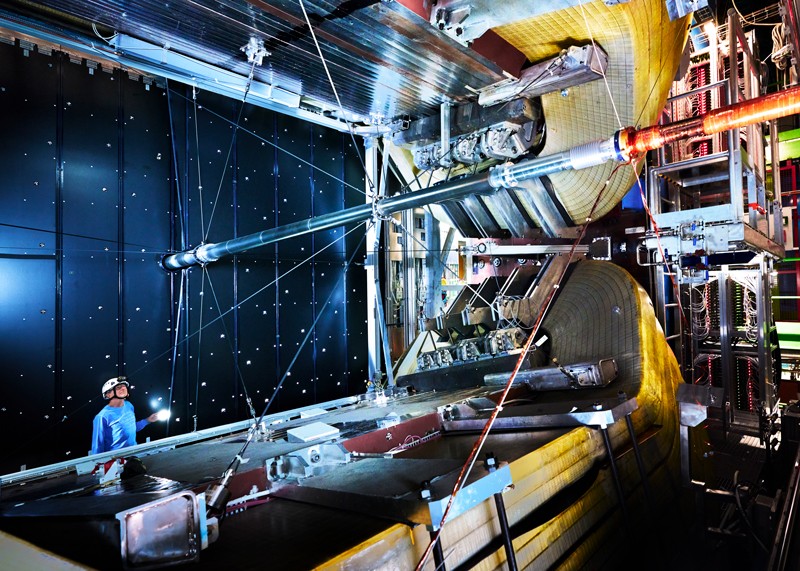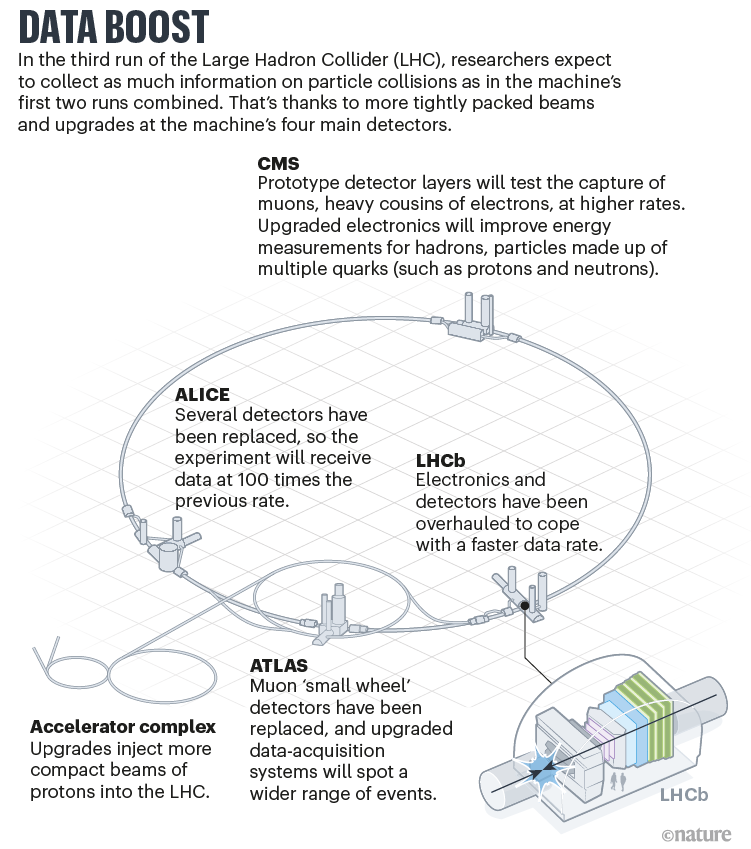Experiments at the world’s most powerful particle collider have restarted at CERN, Europe’s particle-physics laboratory, after a three-year upgrade to its machinery. For its third run, the proton beams of the Large Hadron Collider (LHC) will circulate at higher intensities and record energies. Physicists want to use the collisions to learn more about the Universe at the smallest scales, and to solve mysteries such as the nature of dark matter.
At 4.47 p.m. local time on 5 July, physicists at the laboratory, based near Geneva, Switzerland, turned on the detectors and began taking data. The run follows those in 2009–13 and 2015–18. “It is the first time in what feels like ages, after the pandemic, that we’re opening a window on the Universe to look at what it’s made of,” says Tara Shears, a particle physicist at the University of Liverpool, UK, and member of the LHCb collaboration — which specializes in studying the behaviour of a fundamental particle called the ‘b’, or ‘beauty’, quark.
LINK: How the revamped Large Hadron Collider will hunt for new physics
More-compact proton beams will allow the LHC to maintain a peak rate of collisions for longer, enabling experiments to collect more data in this run than in the previous two combined. A collision energy of 13.6 trillion electron volts (TeV), up from 13 TeV in the previous run, raises the probability of creating heavier and unknown particles (see ‘Data boost’). “With higher-energy data and a larger amount of data we can look further. It is really quite thrilling,” says Shears.
Physicists will use the data deluge to learn more about the Higgs boson, which was discovered at CERN 10 years ago this week and about which myriad questions remain. They will apply new analysis techniques to look for physics outside the standard model, which describes known particles and their interactions. And they’ll explore a shopping list of existing anomalous results that don’t fit with the theory.
These discrepancies include an apparent preference for bottom quarks to decay into electrons rather than their heavier cousins, muons, when the standard model predicts roughly equal numbers of both. If such anomalies are genuine, they could help physicists to explain mysterious features of the Universe that the standard model can’t account for — such as why matter is everywhere but antimatter is scarce. But, if the anomalies arose through chance fluctuations, more data would see the hints fade away.
Back on the beam
Table of Contents
Beams have been circulating in the LHC since April, and some collisions have taken place. But only today was the beam declared safe enough for the experiments to be switched on. Among them are ATLAS and CMS, the LHC’s general-purpose experiments designed to study a wide range of physics.
The particle beam has the power to damage detectors and machinery, so engineers will start cautiously, circulating only a minimum number of protons. This number will then increase over the course of the year, says Mike Lamont, who is director for accelerators and technology at CERN. Eventually, the energy of the tiny, particle-packed beam will be that of a train going at 150 kilometres per hour, “so we have to be very, very careful about this”, he says.
During the scheduled long shutdown, which was extended by the COVID pandemic, the CERN team upgraded the accelerator complex, which generates and accelerates the particle beam. This included installing a new source of protons, to replace technology that had been in use at CERN since 1978.
Physicists upgraded the LHC experiments’ detectors, in particular improving their electronics and computing system to deal with the greater collision intensity. In the CMS and ATLAS experiments, the LHC will collide bunches of around 100 billion protons at a rate of 40 million collisions per second. Each one will produce around 60 proton–proton smashes — each of which will generate hundreds of particles.
Two large experiments have been completely overhauled: LHCb and ALICE, which studies a dense form of matter known as quark-gluon plasma. Whereas CMS and ATLAS should, in effect, double their rates of data creation, LHCb’s rate will be 10 times higher than it was and ALICE will aim to record 50 times as many collisions as before.
High-luminosity machine
The beam, which feeds all the detectors, starts at a low intensity, so it will take months before enough data is available for analysis to begin in earnest, says Shears. Physicists will need to recalibrate the experiments to the new beam and check that the revamped detectors are working as hoped, before making new findings. “You’re not going to see results coming out on day one,” she says.
The LHC will run for four years, until collisions stop to make way for upgrades to an even more intensive machine. This one, known as the High-Luminosity LHC, will start operating in 2029 and will ultimately produce 10 times the data of the LHC’s first three runs combined.
Ahead of the start-up, CERN’s director-general Fabiola Gianotti said it was her dream for the LHC’s third run to find particles that make up dark matter — the mysterious substance that physicists think accounts for 85% of the matter in the Universe. But the experiments’ goals are not to chase any particular theory but to “understand how nature works at the most fundamental level”, she said.


